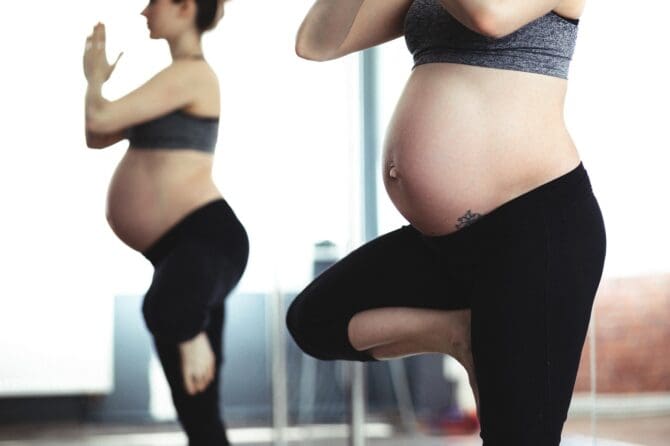Pregnancy presents a unique situation for avid yoga practitioners. Many poses and positions become unsafe as the pregnancy progresses. However, there are still many benefits to practicing yoga while pregnant. Yoga can help with the aches and pains that come along with pregnancy, as well as help prepare the body and mind for childbirth.
But that doesn’t mean you have to stop participating in yoga completely until your pregnancy is over. In fact, yoga may even help you cope with the changes associated with pregnancy physically, mentally and spiritually. Pregnancy can be a difficult time for many women, but yoga can help alleviate some of the stress and anxiety that comes along with it.
Pregnancy will definitely change a woman’s yoga routine and her life in general. Although a pregnant woman may need to modify her yoga routine and cannot do all poses, she can still enjoy some of the benefits with some adjustments.
According to experts, yoga can aid pregnant women by teaching them how to breathe and relax. As anyone who has participated in a child birthing class knows, breathing exercises are an important part of the process. Lamaze classes use deliberate, rhythmic breathing to help women through the childbirth process, but yoga focuses on deep, relaxing breaths.
The breathing exercises taught in yoga can be extremely beneficial for pregnant women, helping them to relax both mentally and physically. These techniques can be especially helpful during times of stress, such as during labor and delivery. By learning how to control their breath, expectant mothers can help reduce the harmful effects of stress on their bodies and their babies.
As stated, there are special considerations that need to be taken by pregnant women when practicing yoga. Many of the precautions are based on the specific trimester that you are in. The following are suggestions on how to modify your yoga practice during each trimester of your pregnancy:
First Trimester: During the first trimester, it is important to listen to your body and not push yourself too hard. Avoid any poses that put pressure on your abdomen or that require you to lie on your stomach. Poses that require balance may also be more challenging, so be sure to use a support if needed.
Second Trimester: The second trimester is generally considered the safest time to practice yoga. Continue to listen to your body, but most poses should be accessible. Poses that involve lying on your back for an extended period of time should be avoided after the first trimester, as they can reduce blood flow to the uterus.
Third Trimester: The third trimester is a time to focus on relaxation and breath work. Poses that require balance or that put pressure on the abdomen should be avoided. It is also important to avoid lying on your back for an extended period of time.
Pregnant women shouldn’t feel guilty about missing a class or moving to a less strenuous class if they are experiencing morning sickness. Morning sickness is a sign that you should alter your routine. During your first trimester of pregnancy, it’s important to tell your yoga instructor about your condition and ask for any necessary modifications to the routine.
Are you pregnant and haven’t tried yoga before? You might be pondering whether it’s worth finding a prenatal class nearby. There are many benefits of yoga for pregnant women, and it can be a great way to connect with other expectant mothers. If you can’t find a prenatal yoga class in your area, there are plenty of options for yoga videos and DVDs that you can use at home.
Pregnant women are advised by yoga instructors to practice specific poses and movements that improve flexibility, especially in the hips, for an easier birth. Recommended poses include the Triangle, Knee to Ankle, the Pigeon, Warrior II, Baddha Konasana and Ardha Chandrasana. Yoga instructors also recommend positions that can actually affect the birth process, such as Cat-Cow, in which the participant is on all f.
Prenatal yoga can be extremely beneficial for expectant mothers, especially during the second trimester when morning sickness has typically passed. Even if you have never tried yoga before, now is a great time to start. However, it is important to take it easy and not push yourself too hard, as well as to avoid any moves that require extreme stretching.
Experts advise pregnant women who practice yoga to avoid jumping, running between movements, or rolling, and to instead use stepping or crawling. During a sun salutation, pregnant women should keep their chest no higher than 85 degrees from the floor and place their hands in front of, rather than alongside, their feet, according to yoga instructors. Also, they recommend avoiding extreme twists which could cause placental abruption, poses that press the h”.
In the third trimester, an expectant mother’s body will go through some changes which may mean she has to modify her yoga practice. Poses that compress the stomach should be avoided, and she should be mindful of her overall fatigue levels. That said, yoga can still be beneficial for her if she’s feeling up for it. Gentle stretches and breathing exercises are usually fine.
Inversion poses, such as Legs Up Against The Wall, Bridge Pose and Downward Dog, can alter the position of the baby negatively. The only exception is if the baby is in a breech position. In those instances, these poses may actually help to turn the baby into the proper position. It’s usually advised for women to restrict the amount of inversion poses done during pregnancy, particularly around 36 weeks.
Only participate in yoga classes that are meant for pregnant women. Bikram yoga, or “hot yoga,” is not recommended as the extreme heat can be dangerous for pregnant women.
During the second trimester, as the baby grows and the woman’s center of gravity changes, she may become more prone to losing her balance. To reduce the risk of injury, she should avoid standing poses and instead do them with the support of a chair or against a wall.
When bending forward, always bend from the hips, not the waist. Keep your chest elevated, and your spine extended from the tailbone to the base of the skull. This technique makes it easier for a pregnant woman to breath. If bending forward while you are sitting, use a towel or yoga strap behind the ankles and hold the strap or towel with both hands. Again, bend from the hip and keep the chest elevated to avoid compressing the abdominal area. Keep the legs open approximately hip width to give your stomach more room.
If you perform a twisting pose, twist from your shoulders and back instead of your waist. Stick to positions that are comfortable to prevent putting unnecessary pressure on your abdominal.
To avoid injuring your back, avoid movements that involve bending it backwards, such as handstands, headstands, and upward bow movements. One-leg balancing and other moves that put strain on your back are also best avoided.
Yoga is a great way to help ease the discomforts of pregnancy and make this amazing time in your life more peaceful. By listening to your body and being mindful of your breath, you can help reduce stress and feel more connected to your baby.











